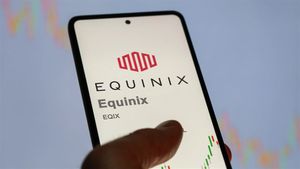
New York, NY – October 2, 2025 – The third quarter of 2025 proved to be a banner period for major US stock funds, with equity markets experiencing a robust rally fueled by persistent enthusiasm for artificial intelligence (AI), strong corporate earnings, and the Federal Reserve's inaugural interest rate cut of the year in September. As of October 2, 2025, broad US equity indices, including the S&P 500 and Nasdaq Composite, have scaled new all-time highs, extending a powerful recovery that initiated after a notable sell-off earlier in the year.
This impressive performance underscores a continued "risk-on" sentiment in the market, with investors flocking to growth-oriented sectors, particularly technology and communication services. While the overall market celebrated significant gains, a familiar narrative emerged in the perennial debate between active and passive investment strategies: index funds largely maintained their outperformance, reinforcing the dominance of low-cost, broad-market exposure in a thriving equity environment. The implications for investors are clear: diversification remains paramount, but the structural advantages of passive investing continue to shine amidst market buoyancy.
Q3 2025: A Deep Dive into Market Performance and Fund Dynamics
The third quarter of 2025 saw the S&P 500 Index deliver a solid 8.1% return, building on momentum from the preceding quarter. Both large-cap and small-cap stocks reached new all-time highs, with the Russell 2000, representing small-cap companies, posting an impressive 12.4% total return, briefly leading the market gains. Growth stocks, while still ahead, saw their lead over value stocks narrow slightly, with the Morningstar US Growth Index returning 6.89% compared to the Morningstar US Value Index's 6.36%. Within the Morningstar Style Box, small-cap growth funds emerged as top performers, averaging 8.54%.
Sector performance was unequivocally led by technology and communication services, which continued their outperformance from earlier periods, climbing 12.4% and 12.75% respectively. This robust growth is largely attributed to the sustained AI boom, which is increasingly viewed as a transformative force across various industries, driving significant productivity gains and investment. Other sectors like energy and consumer cyclicals also posted positive returns of 5.8% and 8.9%, while consumer defensives were the sole sector in negative territory, experiencing losses of 2.71%.
A critical aspect of Q3 2025's performance was the stark contrast between actively managed and index funds. Among the 10 largest actively managed US stock funds, only one, the JPMorgan Large Cap Growth Fund (JLGMX), managed to rank in the top third of its category with a 9.3% return. In sharp contrast, all but one of the 10 largest US stock index funds outperformed their respective categories. The Vanguard Total Stock Market Index Fund (VSTSX) was a particularly strong performer, returning 8.2% in the quarter and placing in the 21st percentile of the large-cap blend category, underscoring the efficiency and broad market capture of passive strategies. The Federal Reserve's decision to cut its benchmark interest rate in September, the first such move in 2025, served as a significant catalyst, bolstering market sentiment and particularly benefiting high-growth tech stocks. This move marked a notable shift from earlier concerns about potential rate hikes due to inflation, contributing to a broader sense of economic optimism among CEOs, with mentions of "recession" dropping by 81% quarter-over-quarter.
Asset Managers Navigate Shifting Tides: Passive Giants Thrive, Active Managers Seek Niche Wins
The robust performance of US stock funds in Q3 2025 has created a dynamic landscape for major asset managers, further solidifying the structural advantages of passive investment while simultaneously challenging active managers to demonstrate their value. Firms like BlackRock (NYSE: BLK) and Vanguard, dominant players in the passive investment space, are poised to be significant beneficiaries of the quarter's trends, while active managers, including Fidelity, face continued pressure to justify their fees amidst persistent underperformance relative to benchmarks.
BlackRock, the world's largest asset manager with trillions in assets under management, is a prime example of a firm thriving in this environment. Its extensive suite of iShares ETFs and index funds directly benefits from broad market rallies and the record ETF inflows observed in Q3 2025. Beyond passive strategies, BlackRock's strategic expansion into private markets, exemplified by its acquisition of HPS Investment Partners in July 2025, aims to diversify its revenue streams with higher-margin, less market-correlated assets. The firm's innovation in AI tools for financial advisors also positions it to enhance client engagement and operational efficiency, further cementing its leadership.
Vanguard, another titan of passive investing, continues to attract substantial client flows due to its reputation for low-cost index funds and ETFs. In Q3 2025, Vanguard was a top absolute ETF inflow leader, with its flagship S&P 500 ETF (VOO) consistently gathering significant assets. The positive market performance amplifies Vanguard's AUM through both market appreciation and sustained investor preference for broad market exposure. While primarily passive, Vanguard also offers successful active fixed income strategies, which provided stability and solid returns in the first half of 2025, demonstrating that even passive-centric firms can find success in specific actively managed niches.
For active fund managers like Fidelity, Q3 2025 presented a mixed picture. While a rising market generally increases their total AUM through capital appreciation, the fundamental challenge of consistently outperforming benchmarks after fees remains. Data from mid-2025 indicated that only about 33% of active funds had beaten their passive counterparts over the preceding twelve months, highlighting the difficulty in justifying higher management fees. However, Fidelity, a prominent active manager, is adapting by focusing on active ETFs, recognizing the growing momentum for this hybrid product. The firm also emphasizes offering comprehensive financial services and leveraging technology to enhance client experience and operational efficiency, crucial strategies for retaining and attracting clients in a competitive market. The success of active fixed income strategies and certain thematic funds in Q3 2025 suggests that targeted active management can still attract significant client flows and demonstrate value, particularly in less efficient markets or specialized areas.
Wider Significance: Reshaping the Investment Landscape and Heightened Scrutiny
The performance of US stock funds in Q3 2025, particularly the continued outperformance of index funds over actively managed counterparts in core US equity segments, is not an isolated event but rather a reinforcement of several profound, long-term trends reshaping the investment management industry. This dynamic has far-reaching ripple effects on competitors, partners, and even draws the attention of regulators, while also inviting comparisons to historical market cycles.
Firstly, the quarter's results underscore the continued dominance and growth of passive investing. This trend, driven by lower fees, consistent performance, and increasing investor awareness of the difficulty in consistently beating benchmarks, has seen passive assets surpass actively managed funds in total AUM in the US by late 2023. If the strong performance of mega-cap stocks persisted in Q3 2025, as suggested by the research, index funds would have continued to benefit disproportionately, making it exceptionally challenging for active funds to outperform in large-cap equities. This structural shift is expected to continue through 2025 and beyond, solidifying the market share of firms offering broad-market, low-cost passive products.
Secondly, the relentless pressure of fee compression continues to intensify across the global asset management industry. The success of low-cost passive products forces all fund types, especially active managers with their typically higher expense ratios, to reduce fees. This creates a widening gap between costs and revenue for many firms, particularly smaller and mid-sized players, driving a need for greater cost efficiency or highly differentiated offerings. This ongoing pressure is a significant factor in the accelerating trend of industry consolidation, where larger asset managers leverage economies of scale to offer competitive pricing and acquire smaller, struggling entities. The Q3 2025 performance, if it continues to highlight active underperformance, could further accelerate this consolidation, as firms seek scale or niche specialization to survive.
The ripple effects extend across the financial ecosystem. For asset managers, smaller, undifferentiated active managers face an existential threat, potentially leading to increased mergers and acquisitions or outright closures. Larger managers with scale benefit from the shift to passive, though they too must contend with internal fee compression. Financial advisors are increasingly building core client portfolios with low-cost passive funds, reserving active strategies for tactical allocations or in less efficient markets where specific expertise can be justified. Meanwhile, technology providers see growing demand for advanced solutions to enhance efficiency, reduce costs, and provide sophisticated data analytics for both active and passive strategies.
Perhaps one of the most significant implications is the heightened regulatory scrutiny on large index fund managers. The growing influence and market concentration of firms like BlackRock (NYSE: BLK) and Vanguard have attracted attention from regulators such as the FDIC, FTC, and DOJ. Concerns have been raised regarding the potential for these "passive" giants to exert undue influence over corporate governance, potentially leading to anti-competitive behavior or promoting specific social policies within their portfolio companies, particularly banks. In Q2 2025, regulatory bodies clarified "passive investment" rules under antitrust law, emphasizing that the exemption for passive investors can be forfeited if they push for specific operational or strategic decisions beyond ordinary corporate governance. These developments suggest that Q3 2025 likely saw increased discussions or early proposals for policies to monitor or limit the influence of mega-indexers, potentially altering how these firms engage with their portfolio companies.
Historically, the active versus passive performance trend is cyclical. While passive investing has generally outperformed active management over the last decade (leading up to 2025), particularly in bull markets driven by a few large-cap stocks, active management has historically shown periods of outperformance during market corrections, higher volatility, and when market leadership broadens. For instance, active funds outperformed passive in 22 out of 28 market corrections over 35 years. The current period, marked by strong, broad-based performance in US equity markets, has largely favored passive strategies. However, if Q3 2025 saw any underlying shifts towards increased market volatility or a broadening of market leadership beyond mega-caps, it could signal a potential future environment more conducive to skilled active managers.
What Comes Next: Navigating a Complex and Evolving Market
The robust performance of US stock funds in Q3 2025 sets the stage for a complex and evolving market landscape in the short and long term. As of October 2, 2025, the market exhibits a bullish sentiment, with major indices at or near all-time highs, yet underlying economic deceleration, persistent inflation, and geopolitical uncertainties loom. Asset managers and investors alike must strategically pivot to navigate these dynamics, balancing growth opportunities with emerging challenges.
In the short term (Q4 2025 - Q2 2026), the US equity market is expected to continue its well-priced bullish rally, albeit with anticipated below-trend economic growth. S&P Global Ratings forecasts US real GDP growth of 1.7% in 2025 and 1.6% in 2026, a deceleration attributed to slower population growth, tariffs, and federal cost-cutting. The Federal Reserve's rate cut in September 2025, with expectations for further easing, is a supportive factor, yet inflation is projected to remain sticky and above the Fed's 2.0% target. Corporate earnings, however, remain a bright spot, with double-digit growth reported in Q2 2025 and record earnings per share projected for the S&P 500 in 2025, led by technology, industrials, and materials sectors. The labor market is showing signs of softening, with unemployment expected to rise, potentially impacting consumer spending.
Looking at the long term (beyond Q2 2026), the outlook for US stock funds is generally more optimistic, with a projected robust rebound and stronger growth in 2026. Forecasts suggest the S&P 500 could reach 7,500 by year-end 2026, driven by accelerating corporate earnings, a more favorable interest rate environment, and the continued proliferation of Artificial Intelligence (AI). Global growth is expected to be sustained but slower, with AI and automation increasingly integrated into business operations, driving efficiency and cost reduction across industries.
Asset managers are expected to implement several strategic pivots. This includes enhanced diversification beyond traditional 60/40 portfolios, focusing on different risk drivers and asset classes, including a greater allocation to alternative investments like private equity, venture capital, real estate investment trusts (REITs), infrastructure projects, commodities, and digital assets, to navigate volatility and inflation. There will be a continued focus on specific equities, particularly US large-cap technology (driven by AI), financials, and utilities, with small-cap companies also expected to gain momentum in 2026. AI and data-driven advisory will become paramount for hyper-personalization, real-time portfolio adjustments, and improved operational efficiency. Dynamic rebalancing will be crucial, balancing long-term hedging with tactical positioning, while fixed income adjustments will prioritize core fixed income for resilience and income generation. Finally, precious metals like gold and silver will likely see strategic allocation for hedging against volatility and inflation.
Market opportunities are abundant, particularly with anticipated Federal Reserve rate cuts stimulating economic activity and supporting corporate earnings. The dominance of AI continues to be a primary driver of investment and market wealth, with a potential shift in focus from AI builders to users. Strong corporate earnings growth and a broadening market rally beyond mega-cap tech into sectors like Industrials and Financials present further upside. Conversely, challenges include below-trend economic growth, persistent inflation, elevated trade tariffs creating uncertainty, a weakening labor market, and concerns about elevated stock valuations and concentration risk in a few mega-cap technology stocks. Geopolitical tensions and policy unpredictability also remain significant drivers of market volatility. The current environment signals an "early-cycle transition" where fundamentals are constructive in areas like banks and small/mid-cap equities, and the earnings growth gap between mega-tech and the broader market is expected to narrow.
Comprehensive Wrap-up: A Historic Rally with Undercurrents of Caution
The third quarter of 2025 will be etched in financial history as a period of remarkable strength and record-breaking performance for US stock funds. The market's resilience, fueled by the relentless march of technological innovation, robust corporate earnings, and a more accommodating Federal Reserve, propelled major indices to unprecedented highs. As of October 2, 2025, the market enters Q4 with continued momentum, yet seasoned investors recognize the undercurrents of caution that accompany such significant gains.
Key Takeaways from Q3 2025: The quarter saw the S&P 500 surpass the 6,500 threshold, closing above 6,700 points by early October, extending its year-to-date rally to over 13%. The Dow Jones Industrial Average powered past 46,000, and the Nasdaq Composite surged, reflecting a continuation of a bull market that has seen the S&P 500 climb over 60% since early 2023. This impressive performance was driven by the persistent Artificial Intelligence (AI) boom, propelling "Magnificent 7" technology stocks to new valuations, with companies like NVIDIA (NASDAQ: NVDA) and Microsoft (NASDAQ: MSFT) leading the charge. Strong corporate earnings consistently surpassed estimates, with the S&P 500 expecting a 5.1% year-over-year rise in Q3 earnings. The Federal Reserve's first rate cut in September 2025, with expectations for further easing, provided a significant tailwind. Importantly, the rally showed broad-based gains, with the Russell 2000 (representing small-cap stocks) leading in Q3 with a 12.4% total return, indicating healthier market breadth beyond just mega-cap tech. Finally, record ETF inflows underscored robust investor confidence.
Assessment of the Market Moving Forward: The market is poised for an "early-cycle transition," where fundamentals appear constructive for sectors beyond mega-tech. The transformative potential of AI is expected to remain a primary market driver, providing both near-term earnings support and long-term productivity gains. The Federal Reserve's easing cycle is anticipated to continue, offering further support, though inflation remains a complex issue, influenced by both monetary and fiscal policies. While corporate earnings are projected to remain strong, valuation concerns are flashing caution, with the S&P 500's forward P/E hitting 24x and the Buffett Indicator at elevated levels, suggesting potentially leaner long-term returns. The growing US debt and budget deficit are also raising alarms, potentially impacting long-term bond yields and overall market stability.
Final Thoughts on Significance and Lasting Impact: Q3 2025 showcased the market's ability to defy a "wall of worries," reaching historic highs on the back of innovation and resilient corporate performance. The sustained AI boom is not merely a technological fad but a fundamental shift driving economic value across industries. The Fed's shift to an easing cycle, coupled with broad-based gains, signals a healthier market structure than in periods solely dominated by a few mega-caps. This period reinforces the long-term trend of wealth creation through equity exposure for American households, yet also highlights the increased sensitivity of the market to potential downturns. The lasting impact will likely be a further entrenchment of AI as a core investment theme and continued adaptation by asset managers to balance passive dominance with targeted active strategies.
What Investors Should Watch For in Coming Months (Q4 2025 and early 2026): Investors should remain vigilant and adopt a strategic, adaptable approach. Key areas to monitor include Federal Reserve actions and inflation data, as any unexpected shifts could alter the Fed's trajectory. The upcoming Q3 earnings season will be critical to justify current valuations. AI developments and broader enterprise adoption will continue to be a key indicator of market direction. The resolution of the ongoing US government shutdown (as of October 2, 2025) and the broader political climate will influence market volatility. Given elevated valuations, investors should also watch for a potential market correction, which could be a healthy rebalancing. Diversification across asset classes and geographical regions, particularly into non-US equities and emerging markets, remains crucial. Finally, the health of the labor market and the evolving impact of trade tariffs will provide further insights into economic stability and corporate profitability. While a "buy-the-dip" reflex, especially in AI winners, and robust liquidity are still evident, suggesting that a trend reversal is not imminent, a strategic and diversified approach is essential to navigate the complexities ahead.
This content is intended for informational purposes only and is not financial advice





